Is prewashing fabric before sewing necessary? And does the answer depend more on the fabric or on the project? For example, is it more important to prewash your fabric before sewing a dress or before sewing a quilt? You may have heard experienced sewists talk about the importance of prewashing fabric. But what does that mean, exactly? And why is it important? I’ve constructed this entire guide around the topic of prewashing fabric and when it is and isn’t the right thing to do. It’s knowledge you’re going to need if you’re to embark on a successful sewing adventure.
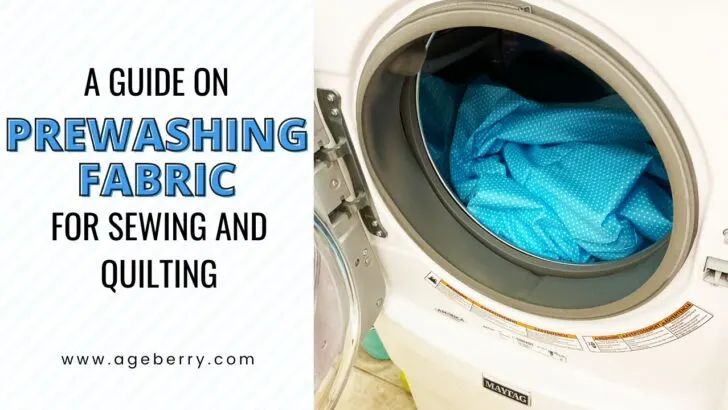
Prewashing Fabric: What Does It Mean And Why Is It A Good Idea?
When sewists speak of prewashing fabric, they’re referring to the practice of washing new fabric before use.
There are several good reasons why you don’t want to skip this step, especially with certain types of fabric.
#1. Shrinking the fabric
The main reason why you need to prewash fabric before using it is that it helps to shrink the fabric. This is especially important for natural fibers like cotton and linen, which can shrink a great deal after washing. Shrinkage is a very common issue when it comes to fabric.
This is due to the fact that the fibers in the fabric will contract when they are exposed to water and heat. By prewashing the fabric before you use it, you can avoid any unpleasant surprises later on because you’re essentially “preshrinking” it. That way, when you do wash it, it won’t shrink as much.
#2. Removing chemicals
Prewashing might also help to remove some chemicals or finishes that may be present on the fabric, which can cause skin irritation or other problems. Fabric finishes are substances that are applied to fabric to give it certain characteristics. Common fabric finishes include water repellency, wrinkle resistance, stain resistance, and flame retardancy. Many of these fabric finishes are applied during the manufacturing process and are designed to remain on the fabric for its lifetime.
However, some fabric finishes, such as those used for temporary fabric protection or for making fabrics more appealing or stiffer, can be washed off. While these finishes are generally safe, they can make fabric less breathable and cause skin irritation in some people.
#3. Removing excess dyes and preventing fabric bleeding
Some fabrics are heavily dyed, and that excess dye can bleed onto other fabrics (or even your hands and ironing board). Fabric bleeding is most likely to occur with dark colors – red, navy, or black, particularly if they are not colorfast.
The simplest way to prevent fabric bleeding is to prewash all your fabric before sewing with it. When fabric bleeding occurs, it is because the fabric dyes are leeching out and staining other fabrics or surfaces. This can happen when fabric is washed for the first time, which is why it’s important to pre-wash your fabric before sewing with it. Pre-washing fabric removes any loose dye particles, and sets the color so that it won’t run or bleed when you wash it with other fabrics.
When it comes to fabric bleeding, there have been some major advances in recent years. Fabric used to bleed quite easily, and this would often result in spots on other fabrics. However, today’s manufacturing processes and dyes are much better, and fabric bleeding is much less of a problem. There are still some fabrics that are more likely to bleed than others, but overall the quality has improved greatly in recent years.
#4. Removing dust or dirt from fabric
Fabrics initially come on bolts or rolls. And bolts must be stored somewhere — usually in dusty warehouses or stockrooms — until they make their way to the store shelves. Prewashing your fabric gets rid of any dust or debris it picked up during storage or transport.
In addition, you can often find good quality fabric in a thrift store at a fraction of the price you would pay retail. For example, I once found six rolls of natural 100% silk fabric at a thrift store. You will certainly need to prewash this kind of fabric because you never know where the fabric has been, so it’s better to be safe than sorry.
#5. Preventing seam puckering or distortion
Seams and hems sewn on fabric that hasn’t been prewashed can distort, pucker, or twist after washing.
When fabric is folded or stored on the bolt the fibers are often stretched disproportionately and pulled out of alignment. In other words, the fabric can become distorted from being folded or wound. Prewashing helps to restore the alignment of the fibers, making the fabric less likely to pucker or distort after washing.
The Importance Of Prewashing Fabric
Let me give you some examples.
This is my 100% silk dress. It has a cotton lining (I would never ever use polyester lining) made from double gauze fabric.
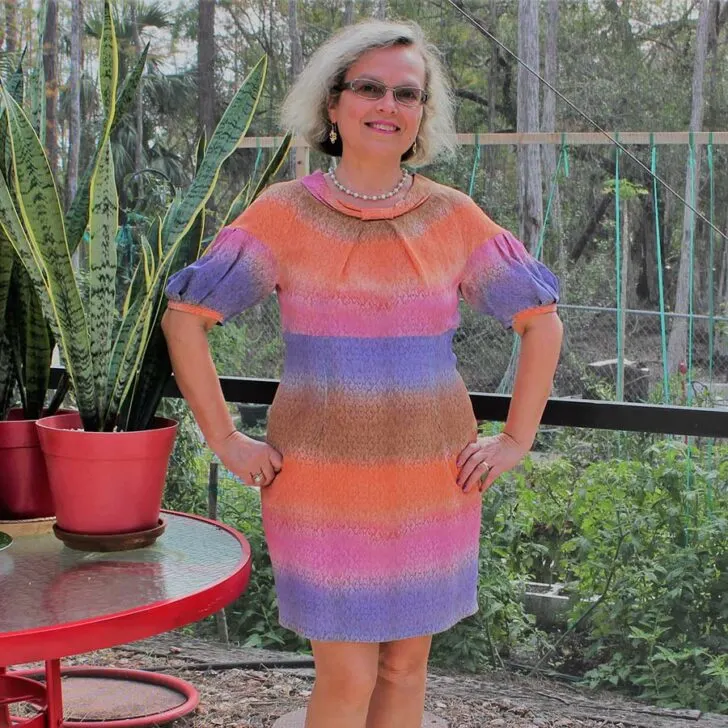
I didn’t prewash the silk fabric – I made the dress before I started to read sewing blogs. And I didn’t prewash the gauze. After the laundry in the washing machine (in cold water) the silk fabric shrunk a little, but the gauze fabric didn’t shrink. As a result, the lining became too long.
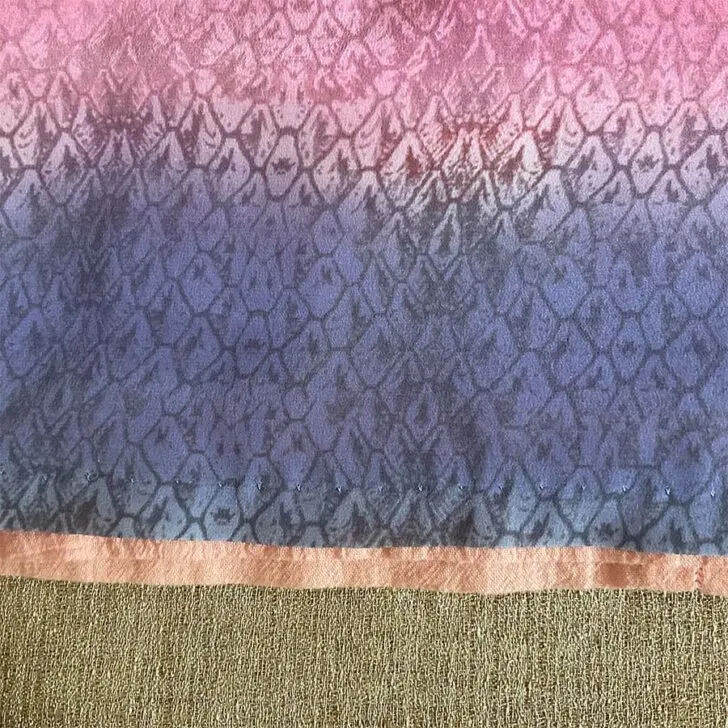
The dress still fitted ok, but the lining could be seen under the hem. Of course, it was easy to fix, but I could avoid it by prewashing both fabrics before cutting them.
It’s a very frustrating experience when it happens to a garment that you’ve spent a lot of time and money on.
Now another example. This is one of my favorite tops. I really like the design – it’s very flattering and fits me well. The knit fabric is really soft and comfortable and I feel great when I wear it.

But I made the mistake of not prewashing my cotton knit fabric before cutting out the pattern, and as a result, the seams became crooked after washing.
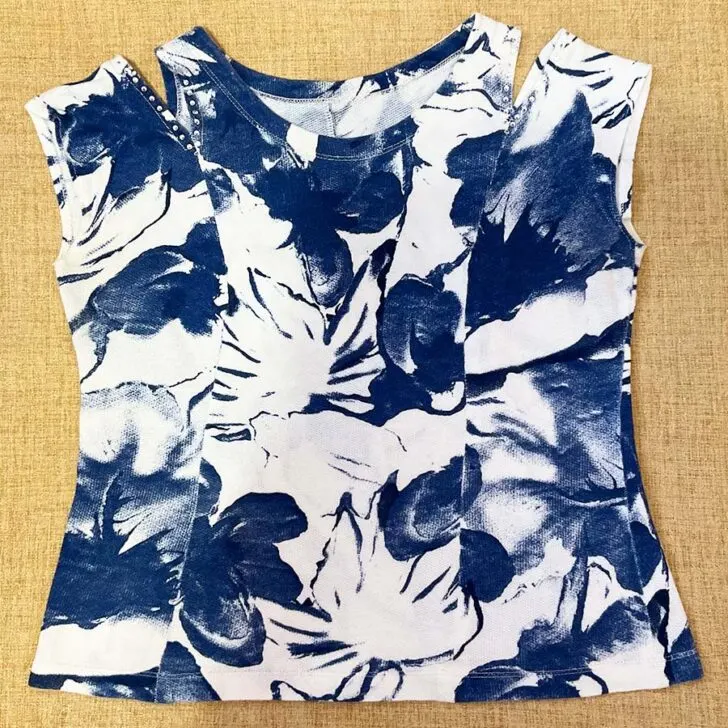
If I had prewashed the fabric, I could have avoided this problem altogether.
Prewashing fabric helps not only prevent shrinkage in future washings but also helps to straighten fabric grain if it was stretched in a fabric store or in storage. This is especially true about knit fabrics. So, if you’re planning on sewing with knit fabric, be sure to prewash it first.
How to Prewash Fabric Safely
The question remains — once you’ve decided your new fabric needs a prewash — how do you go about it? Can you just toss it in the wash on the hot setting and let it go? Or does this task require a bit more subtlety?
Prewashing will make your fabric feel softer and cozier, but if you do it too aggressively, you could cause damage to the delicate threads. You also want to avoid fading or stretching your new yardage. Generally, use these steps to prep new fabric for sewing:
#1. Decide how you will launder the item you plan to make from your fabric. If it requires handwashing, then you should prewash it by hand, as well. If you plan to toss your finished project into the washer, then it’s okay to do the same with your fabric.
#2. Finish the raw edges of woven fabrics that are likely to fray or unravel during washing. Use your serger or a zigzag stitch to sew around the cut edges of the yardage (not the selvages though) before prewashing. You can also use pinking shears.
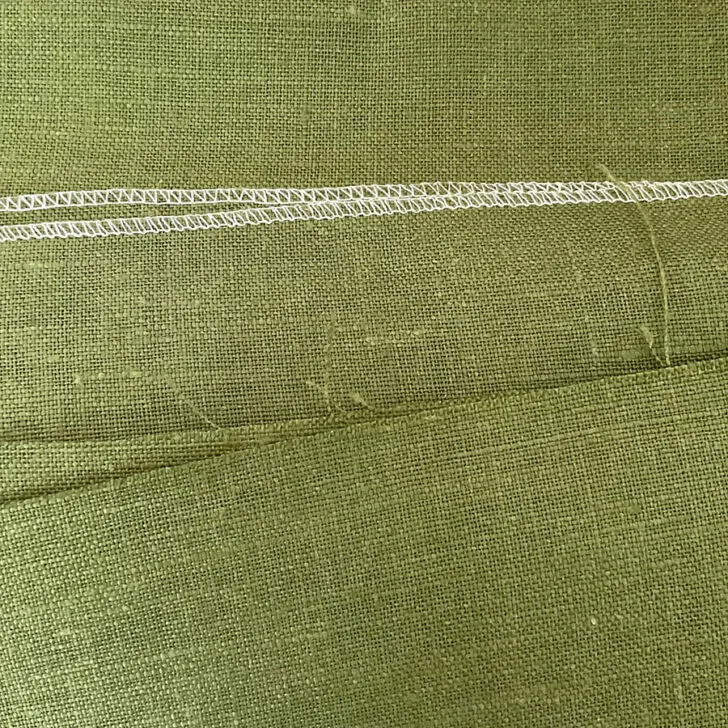
#3. Rinse with plain water, avoiding the use of fabric softener.
#4. Lastly, toss your fabric in the dryer, hang-dry it, or place it flat on a drying rack, according to the type of fabric you’re prewashing. Once it’s dry, press it.
It seems so simple. But in reality, there are many questions that remain.
So now let’s take a closer look at this process and talk in more detail about prewashing fabric effectively.
Is It Important to Read the Fabric Care Instructions?
So, it’s often recommended to note the care instructions for the particular fabric you purchased because they’re designed to prevent damage to the fabric. Fading, bleeding, bleaching, and fraying are all possibilities if you prewash your fabric incorrectly. And some fabrics are much more delicate than others. If you ignore the care instructions, you may find yourself back at the fabric store, buying your yardage all over again.
Ok, it makes sense. But where in the world can I find these instructions? Of course, if I buy fabric online it’s easy to find care instructions in fabric descriptions.
But when you buy fabric in a fabric store, do you really read the fabric label on a bolt? And after that remember what it was? I never do that. But I know general care instructions for different types of fabric like cotton, silk, linen, etc. And I think it’s enough for me to prewash the fabric properly.
Moreover, I might just not agree with the fabric care instructions provided by the manufacturer. Look at the image above – the fabric is 100% cotton, but it’s recommended to wash it in cold water and tumble dry low. Well, it might be good for the garment made from it but not for the fabric itself before it was sewn. Prewashing in cold water might not preshrink cotton fabric enough and I certainly want to preshrink it before using.
And it’s happened to the best of us – you put a garment in the wash, forgetting that it needs to be washed in cold water, and then it shrinks.
To avoid this mishap in the future, I recommend pre-washing most of your fabrics in warm or hot water. That way, if you accidentally put a delicate item in the wash with other garments that need to be washed in hot water, it will already be preshrunk and won’t suffer any damage. I’ve been doing this for years, and it has saved me from shrinkage and other damage that can occur when washing on high heat.
Which Fabrics Require Prewashing?
Most fabrics benefit from a prewash. Natural fibers, such as cotton, linen, and wool, are prone to shrinking. Synthetic fibers, such as polyester or acrylic, may bleed color. Therefore, unless the manufacturer specifically instructs you not to prewash, it’s always a good idea. However, different fabrics have different washing requirements.
Prewashing Cotton Fabric
Generally, 100% cotton fabric can be machine-washed in hot or warm water and tumble-dried on a regular setting. Ideally, you want to maximize shrinkage on the prewash, so that when you wash your finished project, it’s less susceptible to distortion.
For years I was only sewing clothes and I didn’t make quilts. But now I love quilting and I am getting familiar with quilting cotton fabric which I rarely used before.
One of the great things about quilting cotton is that it comes in such a wide variety of colors and patterns. And one of the most popular trends right now is quilting cotton with metallic accents. There’s something about the way the light catches the glitter that just makes the fabric look so special.
Whether it’s gold or silver paint on the right side of the fabric or golden or silver threads directly woven into the material, these fabrics add a touch of luxury to any project. But one question that often comes up is – what will happen to all those sparkles after laundry? Will they disappear?
I have several quilting cotton fabrics with metallic accents. For example, this cotton fabric has a gold foil print that would be perfect for a variety of projects.
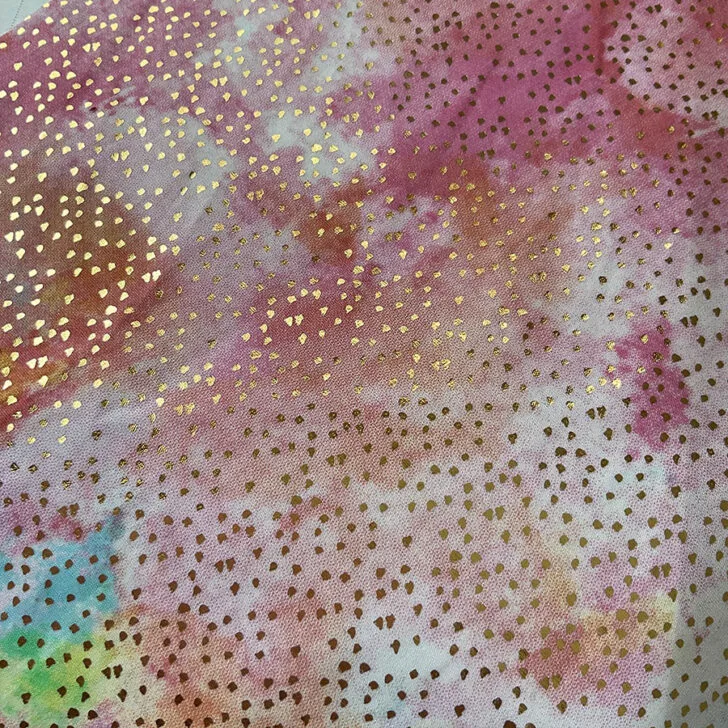
I also have this beautiful Christmas fabric with silver and gold designs.
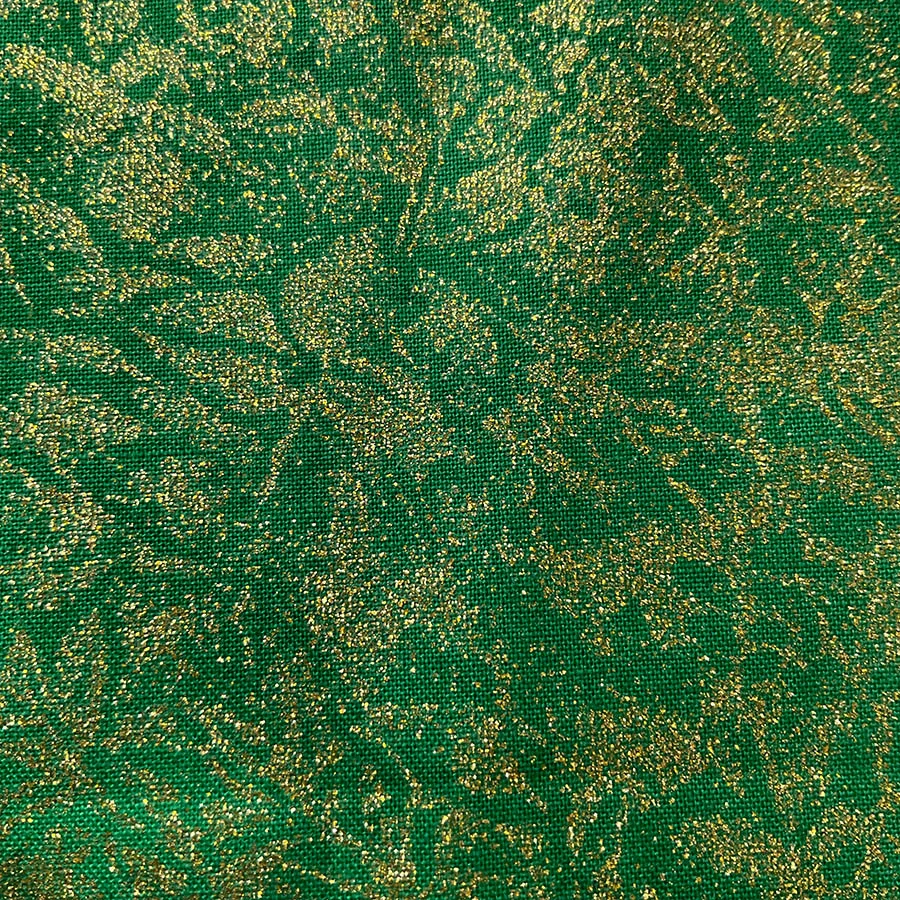
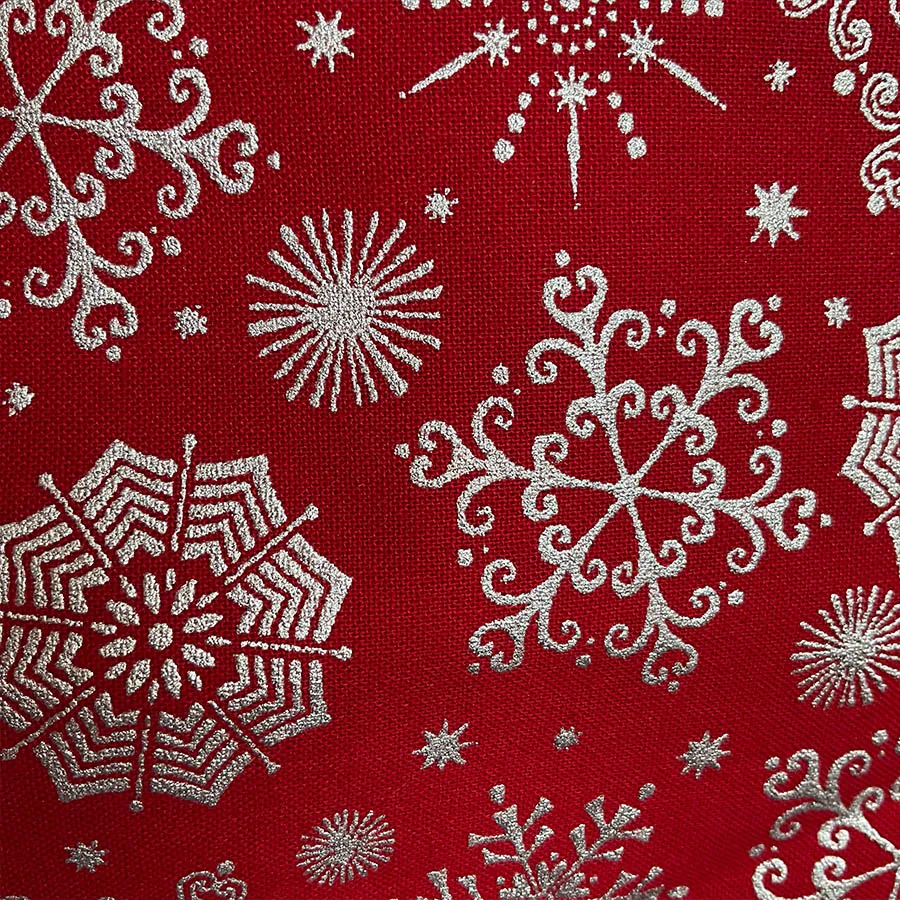
Or this lightweight cotton with golden threads woven throughout that would make an elegant modern quilt.
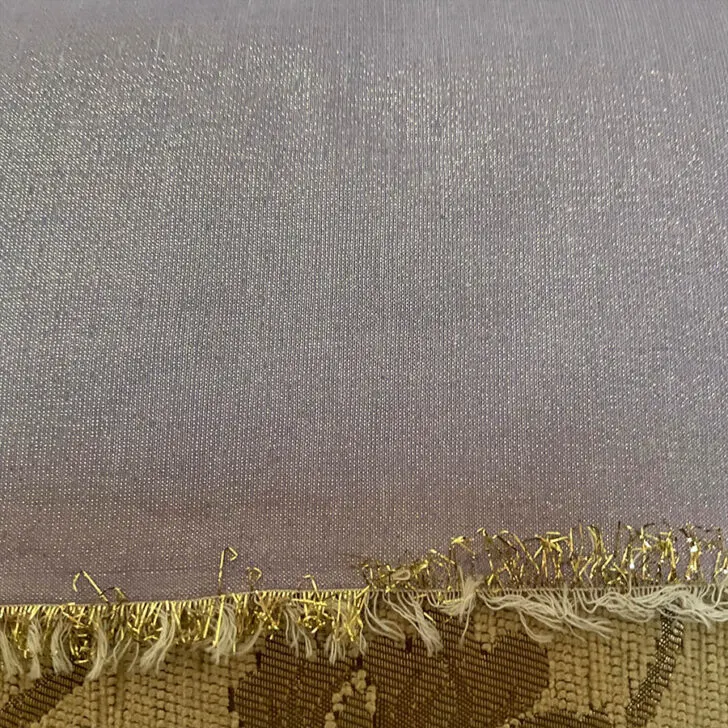
I did a little experimentation and discovered that all my quilting cottons with sparkles (and I have many more fabrics I am not showing in this article) resisted fading. I washed them in hot water and put them in the dryer on a regular setting to see how the sparkles hold up. In all cases, the sparkles stayed in place and the fabrics looked as beautiful as before laundering.
However I got another problem – the fabrics were wrinkled after prewashing and it was hard to get the wrinkles out even after pressing on the highest setting of my steam iron. But the good news is that on the right side of the fabric, I couldn’t see any wrinkles because of the prints and sparkles.
So the conclusion is that in most cases, it’s a good idea to prewash quilting cotton fabric with gold or silver designs to prevent the fabric from shrinking later on.
However, test a small sample before you commit to using a particular fabric. Simply wash and dry a small swatch of fabric and see how the sparkles hold up. That way you can be sure that the fabric will work well for your project.
Prewashing Flannel Fabric
Flannel is a type of brushed cotton, which makes it highly susceptible to shrinkage. Machine-wash and dry on warm-to-hot settings.
Once I decided to prewash 2 different flannel fabrics together. One was blue and another one had a lot of red. And after prewashing, my blue flannel got many permanent pinkish stains as you can see in the image below.
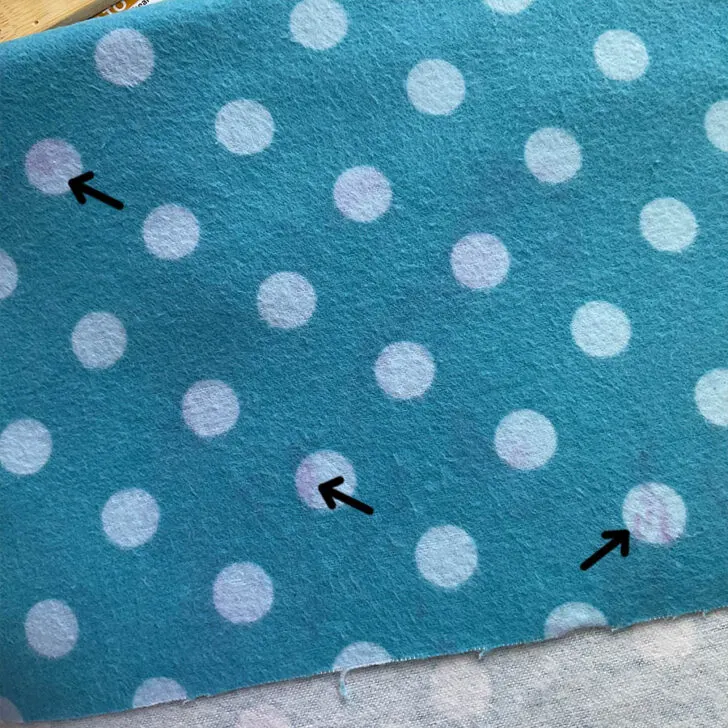
One way to prevent color bleeding is to use color catchers. Color catchers are designed to absorb excess color. To use a color catcher, simply place it in your washing machine with your fabrics (or clothes). The color catcher will isolate the colors and prevent them from bleeding onto other items.
Prewashing Linen Fabric
Linen can be both washed and dried on a hot setting. Expect your yardage to emerge from the prewash softer and more pliable. But it’s a real nightmare to iron linen fabric. The wrinkles just don’t go away.
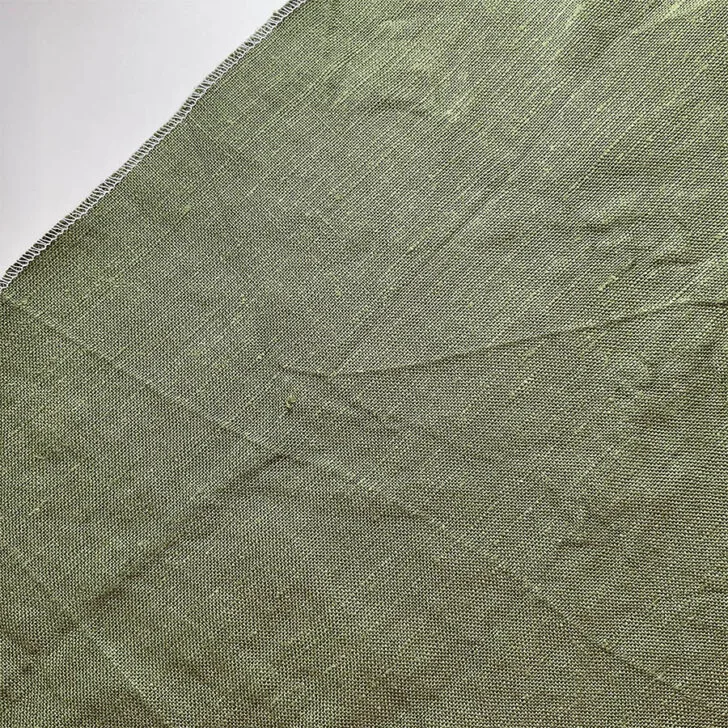
Prewashing Fusible Interfacing
Fusible interfacing can be prewashed simply by soaking it in a tub of hot water until the water cools, rolling it in a towel to remove excess moisture, and hanging to dry.
Should I Wash Fabric Before Quilting?
Should quilt fabric be prewashed? Honestly, it may depend on who you ask. Many diehard quilters say it’s not necessary, because washing the quilt after it’s finished contributes to the soft, wrinkly texture quilts are supposed to have.
Other sewists wouldn’t dream of piecing a quilt with unwashed fabric.
There is one mistake you absolutely want to avoid, and that’s washing a quilt top after it has been pieced, but before it has been sandwiched and quilted. This can cause your pristine quilt top to stretch, distort, twist, and fray to the point where it becomes unusable.
So, the bottom line? Either prewash your quilt fabric before you begin piecing your quilt top, or wait until your quilt is completely finished to wash it. It’s really just a matter of preference. Although prewashing bright, bold colors may prevent your quilt patches from bleeding into one another all over your finished project.
Ok, so now let me veer off topic a bit, but I wanted to show you this because it’s still very much connected to the topic of prewashing fabric.
As you can see in the image, on the left it’s my regular size sweater and on the right it’s my favorite cashmere sweater after I did laundry with it in COLD water (in a washing machine though). As you can see, it shrunk a lot! It’s now only good for a 3 year old.
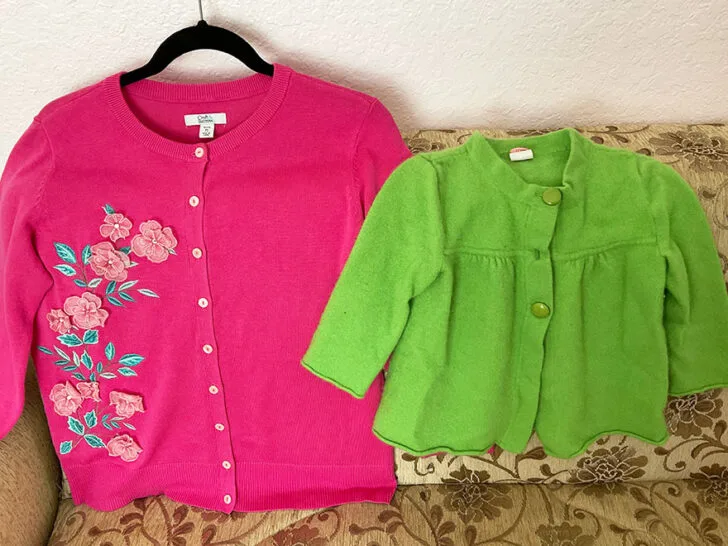
Ok, I didn’t make the green sweater myself, it’s a store-bought item. But the point is, if you don’t prewash (or preshrink) your fabric when you make your garments, this could happen to you too.
When sewing your own clothes, you have the ability to choose from a wide range of high-quality fabrics, including natural silk, organic cotton and linen, and natural wool such as cashmere. By using these luxurious materials, you can create garments that are not only beautiful but also built to last. In addition, sewing your own clothes gives you the opportunity to add personal touches that ensure your clothing is one of a kind. Whether you’re looking for a unique style or superior quality, sewing your own clothes is an excellent way to get exactly what you want.
For example, it can be hard to find a 100% cashmere skirt or a natural silk dress in stores and they would be very expensive too, but if you sew your own clothes you can choose any fabric you like.
When it comes to choosing fabrics, there are endless options available. From natural fibers like cotton and wool to organic silk and linen, the choices can be overwhelming. However, when you’re looking for a fabric that is both luxurious and durable, cashmere is an excellent option. Cashmere is known for its softness and strength. And, thanks to Etsy, it’s now easier than ever to find beautiful cashmere fabrics. So go ahead and indulge in a little luxury – your cashmere fabric awaits!
But after you spend a small fortune on the gorgeous fabric – pretreat your fabric before you start cutting it so your work doesn’t go to waste. It’ll make all the difference in the final product. But if you are wondering how to pretreat cashmere and wool in general I will publish another article soon with detailed instructions. This one is getting too long already.
Do you make a habit of prewashing fabric before quilting or sewing? Do you notice a difference when you don’t? Let me know how prewashing or not prewashing has impacted your most recent project.
Did you find this tutorial helpful? If so, save this pin (see below) on your sewing board so you can come to this tutorial later when you need this information on prewashing fabric, and follow me on Pinterest for more tips, tutorials, and inspiration!
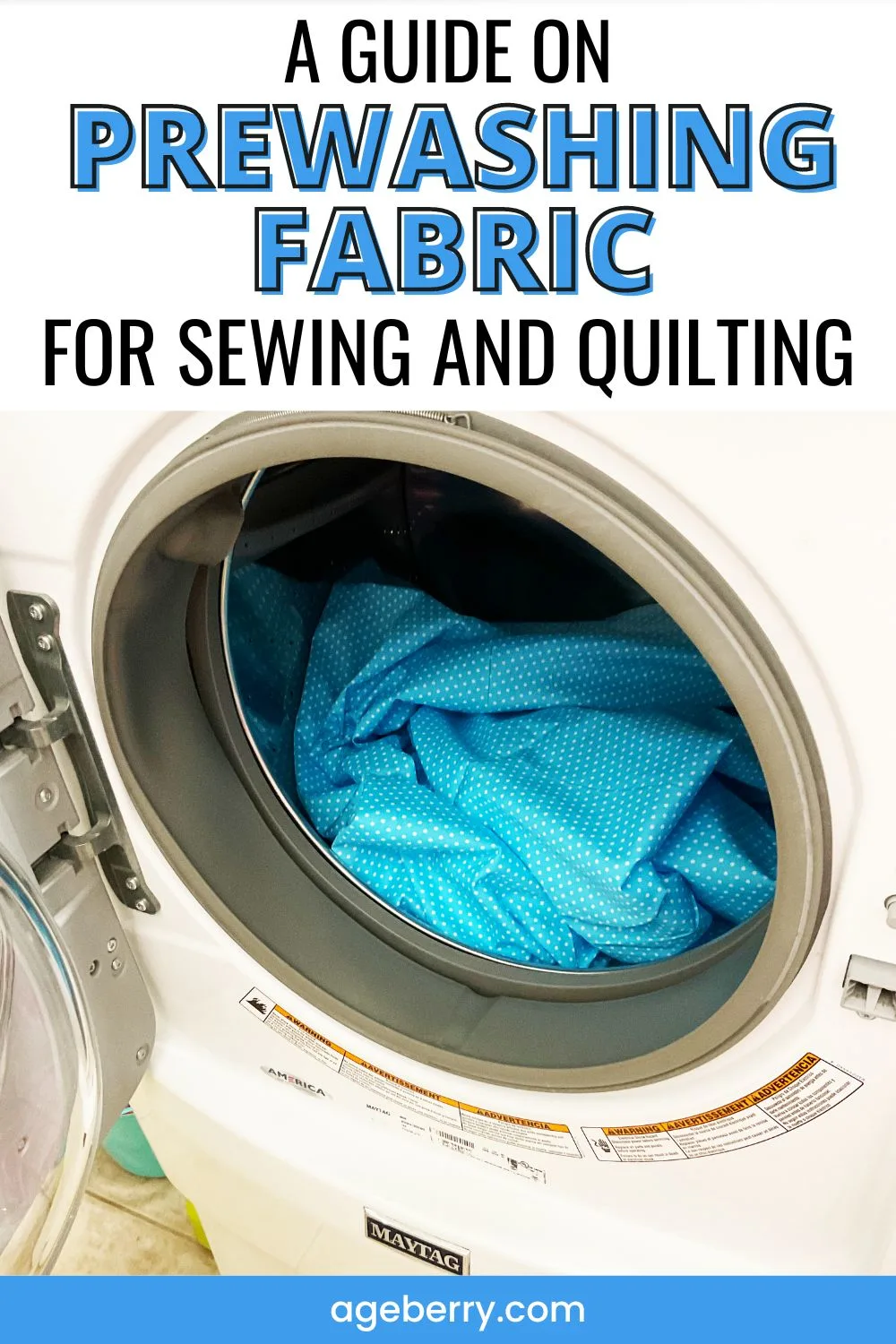
latest posts
- Adorable DIY Needle Book | Easy Tutorial for Beginners
- Master the Seam Ripper: Your Ultimate Guide to Precision Stitch Removal
- Think You Know Zippers? This Installation Guide Might Surprise You
- Why Does Your Seam Ripper Have a Red Ball? Discover Its Purpose!
- Topstitching Troubles? This Simple Trick Will Turn It Around Instantly!
- How to Sew Shirring: A Step-by-Step Guide to Elastic Thread Gathering
- Are Self-Threading Needles Really Useful?
- Amazon Spring Sale: Best Choices
- Elevate Your Prom Look: A Guide to 10 Neckline Choices (2024)

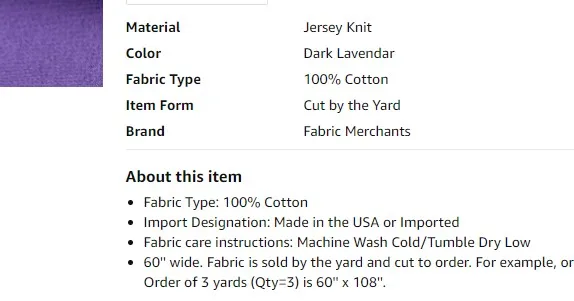
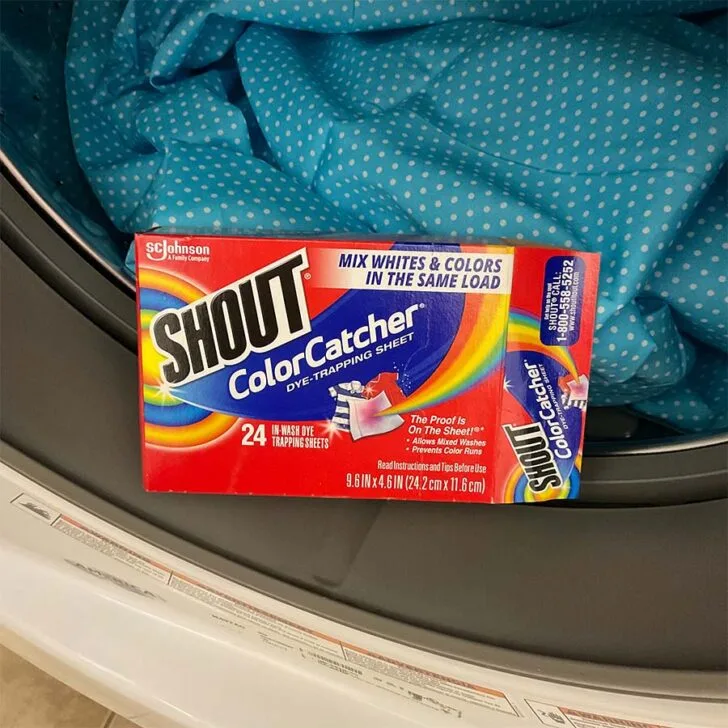
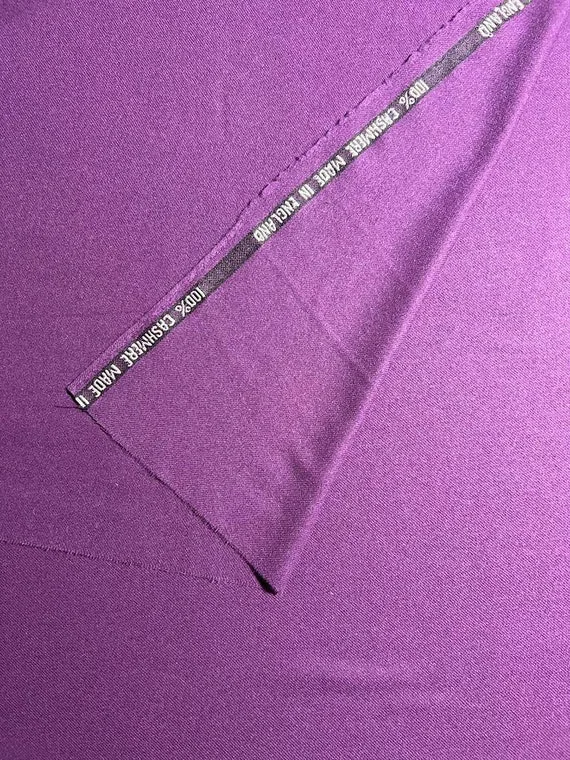
Margaret
Saturday 7th of January 2023
This was very useful for me, a beginner quilter. I have a Christmas quilt that my mom made many years ago. It is mostly reds, greens and golds. It needs to be washed. I know she did not prewash it. I am scared to death the colors, especially the red will bleed. Do you think the color catcher will work on this? I hate to ruin her quilt. She passed 9 years ago. Thank you for your advice.
Olga Balasa
Monday 9th of January 2023
Color catchers can certainly help when washing fabrics of multiple colors, but don't expect them to be a perfect solution. While they can help reduce the amount of red and green color bleeding, there may still be some - nothing completely eliminates it, especially if the fabric is quite old in your case. That being said, I've had good results with color catchers, so it may well be worth a try. Use a delicate cycle and cold water.
Dawn H.
Saturday 15th of October 2022
Should printed cotton fabric be pre-washed if the care instructions on the website are to dry clean only? I bought some home deco fabric to make a roman shade for my kitchen window over the sink. At this location, I know it will eventually get dirty from splashes unless it's pulled up all the time. So, I'm wondering how this fabric will behave with washing later instead of dry cleaning. What's your experience with washing/cleaning this type of fabric?
Liz Fergus
Thursday 8th of December 2022
@Olga Balasa, When I have longer lengths of a washable fabric, I will zig-zag the cut ends or serge them. Then I will fold the length a couple of times or even more depending on how long the piece is and then use a long basting stitch on my sewing machine down the center of the piece. While in the washer, this keeps it all from twisting and wrinkling like crazy. I want to know if you have a better way to prevent the twisting of a long piece of cloth. I have never seen this problem addressed. Thank you, Liz
Olga Balasa
Sunday 16th of October 2022
Cotton can clearly be washed. The printed pattern, who knows, but it is a given that it will eventually fade with washing, even if it does allow washing. I suggest the simplest method of all: try it on a small piece, see how it behaves. You can even dry the test piece and wash again, see how well it stands the operation. And when you do. perhaps you let us know what happened?
Jacque
Friday 30th of September 2022
Very good information. Basics that I need to make sure my projects are successful!
Olga Balasa
Monday 3rd of October 2022
Thank you!
Gigi
Sunday 25th of September 2022
Hi and thanks ! I sew with linen a lot , my favorite fiber ( next to silk). I prewash my fabric but never put it in the dryer ! ( same for silks)! 😱 This goes for table and bed linens, kitchen towels and clothes all made in linen. Lay them flat or hang to dry and then iron while still damp. No wrinkles! I think the dryer is hard on linen fibers and weakens them considerably. Whereas hang drying allows linen to retain its iconic crispness while still being soft from washing. Hope this helps.
Olga Balasa
Monday 3rd of October 2022
Thank you; I agree. But sometimes I find myself using the drier because it is less trouble ...
Edie
Sunday 25th of September 2022
I always prewash any fabric before sewing with it. Years ago, I was in a hurry to sew a dress and didn't prewash the fabric. Unfortunately, it shrunk and was unwearable after the first time I wore it. A lesson well learned!
Olga Balasa
Monday 3rd of October 2022
As they say: every kick in the rear is a step forward. Of course all of us had the same experience at some point.